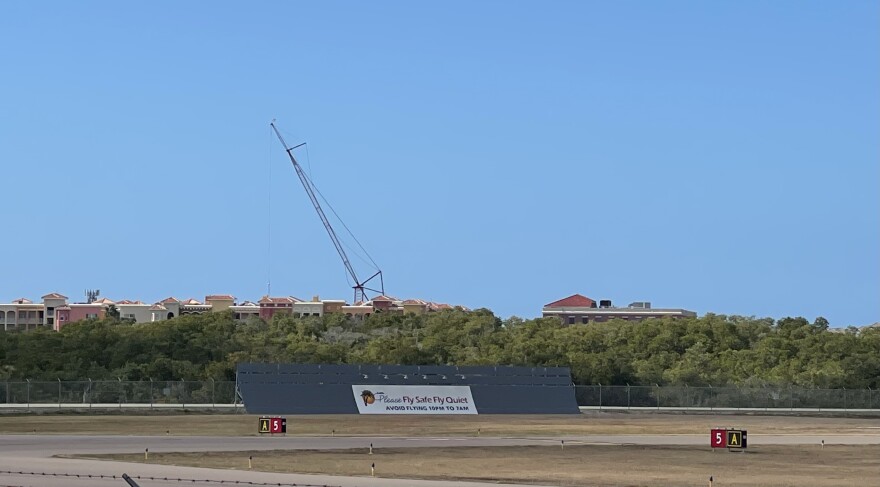The Part 150 Noise Study has entered phase two at Naples Airport. The name of the study comes from the Code of Federal Regulations Part 150. It's a process that airport operators can undertake to make the airport less noisy to surrounding communities.
The study, which started in 2020, completed phase one last December. The first phase involved looking at the noise conditions in the current operating condition, and also five years into the future. Now, the Noise Compatibility Program, or phase two, will look at ways to improve the compatibility of the airport with those areas exposed to high noise levels.
“This is really the part where it's most important that we get community engagement and feedback and suggestions for ways to mitigate the effects of aircraft noise on the community,” Diane Cooper, Naples Airport’s Deputy Executive Director, said at last month’s open house for the program.
In 2021 the airport had almost 118-thousand operations, and 43 percent of those were jet operations. The facility is home to a variety of aviation-related businesses such as flight schools, aircraft charters and aircraft rescue services. In the past 20 years the airport has spent almost $9 million on a variety of different analyses and studies to improve the relationship with the surrounding community.
It's no surprise that a main concern from people who live near the airport is nighttime noise from jets. The Naples Airport has encouraged curfew hours of 10 p.m. to 7 a.m. But the airport cannot regulate the hours because those rules are made at the federal level. Still the airport will take three measures in hopes of improving the situation. The actions came from the phase one studies. Those are noise abatement, land use and administrative measures.
“Each nighttime activity and overflight have the potential to wake thousands of people,” study manager Mike Arnold said. “So, it's a particular focus of many of the measures that are being suggested for evaluation in the next phase of the study.”
Lauren Tobal was affected by the jet noise for 16 years when she lived in Naples.
“I would notice it during the day, but I think it really caught my attention at night because it’s when I’m trying to wind down and go to bed,” Tobal said. “It really sometimes sounded like it was about to crash into my house.”
Zach Burch, the community engagement and communications manager for the airport, said during the open house that 98.5 percent of flights from the Naples Airport occur during the non-curfew hours.
“We’re certainly not content, we’re always looking for ways to improve it, but we don’t have the ability to ban aircraft from flying during that time due to FAA regulations,” Burch said. “But we’re working with operators, with pilots and with aircraft owners to try to improve that as much as we can.”
Elite Jets, one of the largest tenants of the field with a fleet of six jets, conducts its flights the second most often during curfew hours. NetJets has the most flights in curfew hours.
“Some say that we want to upset the people and the neighbors, and the answer is no,” Elite Jets Senior Vice President Stephen Myers said. “I think understanding more about the reason for the traffic and the type of traffic is important.”
Myers made the point that many of the flights that happen overnight are part of public duties.
“Even though you may not come to the airport and step onto an aircraft, you do use the airport, it’s vital to you,” Myers said. “That’s where Mosquito Control District flies, it’s where the Collier County Sheriff’s Office comes out when there’s an active shoot, or some other criminal activity that’s going on. And most of the time, those things happen at night.”
Arnold emphasized at the open house that a plan of action is being considered to re-direct noise after dark.
“One of the things that popped up since the very outset of the study was reducing flights during the nighttime quiet hours at the airport," Arnold said. “We're taking a look at strategies on how to do that. There's also a number of measures that are looking at using compatible corridors around the airport like the Gordon River, maybe routing some of the departures or arrivals over those areas instead of the residential areas.”
Sara DePrisco works near the airport, off of Enterprise Avenue. She said people at her workplace try to make light of the situation.
“It's become a bit of a running gag in in the office where you hear an airplane overhead and you just audibly shout, ‘Oh, there goes an airplane’ or something to that degree,” DePrisco said. “The walls will literally shake when there’s a larger plane coming overhead. It’s something that stops us in our tracks most of the time.”
The current plan for the full Part 150 Study involves conducting more outreach efforts to identify the specific measures that need to be taken, and then moving into the evaluation phase. By summer or fall of this year, the Noise Compatibility Program draft will be complete, and recommendations will be released for public review and comment. After conducting formal public open houses and hearings, all the information will be sent to the FAA for determination.
For now, charter companies such as Elite Jets say they will continue to work with the airport to show they care about the nearby residents.
“We want to be good tenants, we want to be good neighbors, we’re not looking to upset anything, but we do have a fleet and we do have a lot of operations,” Stephen Myers of Elite Jets said. “It's a non-binding voluntary curfew, and we already notify our employees, we notify our passengers, we notify the other operators for all of that, so we want to be good neighbors and we're looking to improve that as well.”











